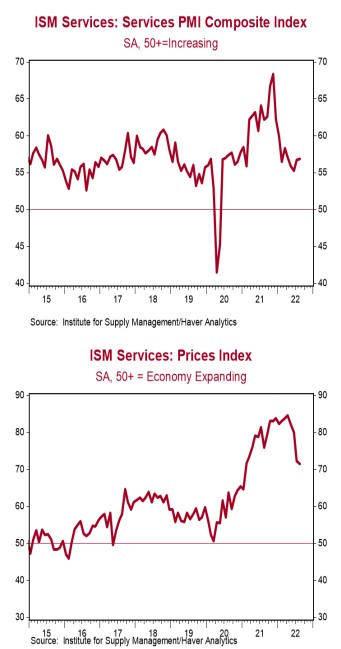- The ISM Non-Manufacturing index increased to 56.9 in August, easily beating the consensus expected 55.3. (Levels above 50 signal expansion; levels below signal contraction.)
- The major measures of activity moved mostly higher in July, and all stand above 50, signaling growth. The new orders index rose to 61.8 from 59.9, while the business activity index also increased to 60.9 from 59.9. The employment index rose to 50.2 from 49.1, while the supplier deliveries index fell to 54.5 from 57.8.
- The prices paid index declined to 71.5 in August from 72.3 in July.
Implications:
Today’s ISM Services report affirms the US economy is not in a recession, as the headline index accelerated to 56.9, and the underlying details of the report were very healthy. New orders and business activity, the two most forward-looking pieces of the report, both broke into the 60s, and sit at the highest levels in 2022. Meanwhile, the supplier deliveries index continued its downward trajectory, falling to the lowest level since before COVID began. Although the movement in this index signals that supply chains in some places may be finally returning to normal, it will take years for them to fully heal from the impacts of shutting the economy down. That is clearly seen in the survey comments, which are still plagued with woes of long lead times, material shortages, and difficulty finding labor. There was also an improvement on the hiring front, as the employment index broke back into expansion territory at 50.2. The case remains that a lack of supply is what’s holding the employment index from moving higher, not demand. Finally, the highest reading for any category continues to come from the prices index, which fell to 71.5 in August. Although that is far off from the 84.6 peak back in April and could signal that inflation pressures have peaked, it is undeniable that inflation remains a problem, as seventeen out of eighteen industries reported paying higher prices in August. We believe the service sector will lead the US economy higher in 2022, as consumers shift their spending habits away from goods and toward the still reopening service sector. Keep in mind that pre-pandemic, services made up roughly 69% of consumption spending. That number fell to 64% during the depths of the pandemic as people stopped going to concerts, movies, restaurants,…etc. Expect to see continued growth in the service sector in the months ahead as spending continues to shift back to the pre-pandemic status quo.





